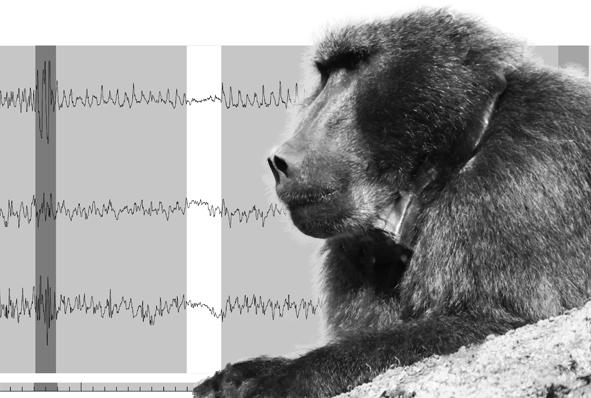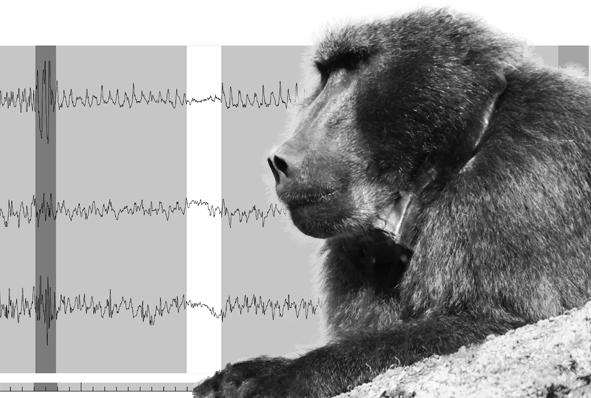
Credit: Gaëlle Fehlmann, Swansea University.
Scientists from Swansea University's College of Science are part of an international team attempting to better understand the human-baboon conflict in Cape Town, South Africa.
"Raiding baboons are a real challenge in the Cape Peninsula, South Africa", said Professor Justin O'Riain from the University of Cape Town, a co-author on the study published by the journal Animal Biotelemetry, who has been studying baboons in the region for over a decade.
"The baboons enter properties to raid in gardens and bins, but also enter homes and sometimes take food directly from people."
In a previous study, the team showed that whilst the management strategy was keeping baboons away from the urban space, some males were still finding ways in. The team therefore wanted to understand how the baboons were doing this.
"Raiding events are so fast, so intense, that we couldn't keep up following them by foot in urban areas with high walls and security fences. We had to find another method to document the very special techniques baboons were adopting when raiding," said Swansea University PhD researcher Gaëlle Fehlmann, lead author of the study who carried out the fieldwork in South Africa.
"Here at Swansea's Laboratory for Animal Movement we have been developing new technologies to study animal behaviours and use accelerometers to quantify how much an animal moves in the three dimensions," said Dr Mark Holton, co-author of the study.
Such methods have been used for more than a decade, but mainly on birds or sea mammals. The Swansea team designed and built bespoke collars for the baboons that would enable them to precisely track the baboons.
"Our preliminary collars that we deployed in the first field season came up with interesting results, but only provided a couple of weeks of data; they needed to be more robust to keep up with the baboons," added Dr Andrew King, head of Swansea University's SHOAL (Sociality, Heterogeneity, Organisation And Leadership) research group in the College of Science, who is the senior author of the study.
So, the team went back to the drawing board and thanks to the engineering skills of Dr Mark Holton and Phill Hopkins, they came up with the "F2HK" collar.
"We thought about every tiny detail, we even enlisted a local saddler to produce the collar from super soft leather that is normally used to line horses' harnesses," explained Ms Fehlmann, who also created a short movie to document the whole process.
And the results exceeded expectations. The 10 collars deployed in the second field season accumulated 252 days of data, recording acceleration in 3 dimensions at 40 times per second and taking a GPS fix every second too.
Dr King added: "Using these data we were able to tell what the baboons were doing for every second our collars were recording; we can now recognise over 90% of baboons behaviours without ever actually seeing the baboon!"
Now that the team is able to remotely track the fine details of baboons' movement, the next step is to use this technology to uncover the secrets of the baboons raiding tactics.
###
A full copy of the paper, "Identification of behaviours from accelerometer data in a wild social primate", published in the journal Animal Biotelemetry, can be found here http://animalbiotelemetry.biomedcentral.com/articles/10.1186/s40317-017-0121-3.
This work was supported by research grants from the Association for the Study of Animal Behaviour (ASAB), Society for Experimental Biology, Natural Environment Research Council (NERC) and Swansea University in the UK and the University of Cape Town and the National Research Foundation (NRF) in South Africa.
Notes for editors:
Images to accompany this story can be found here: https://www.dropbox.com/s/qvh3a6f0lpe4iry/IMG_3708-1-2.jpg?dl=0 https://www.dropbox.com/s/s1mqjekb9n0e2tu/pressillustration.jpg?dl=0
A video by Gaëlle Fehlmann, lead author of the study who carried out the fieldwork in South Africa, can also be found here, https://www.dropbox.com/s/npvm32exef58ysv/Project.avi?dl=0.
Swansea University is a world-class, research-led, dual campus university. The University was established in 1920 and was the first campus university in the UK. It currently offers around 350 undergraduate courses and 350 postgraduate courses to circa 20,000 undergraduate and postgraduate students.
The University's 46-acre Singleton Park Campus is located in beautiful parkland with views across Swansea Bay. The University's 65-acre science and innovation Bay Campus, which opened in September 2015, is located a few miles away on the eastern approach to the city. It has the distinction of having direct access to a beach and its own seafront promenade. Both campuses are close to the Gower Peninsula, the UK's first Area of Outstanding Natural Beauty.
Swansea is ranked the top university in Wales and is currently The Times and The Sunday Times 'Welsh University of the Year'. It is also ranked within the top 350 best universities in the world in the Times Higher Education World University rankings.
The results of the Research Excellence Framework (REF) 2014 showed the University has achieved its ambition to be a top 30 research University, soaring up the league table to 26th in the UK, with the 'biggest leap among research-intensive institutions' (Times Higher Education, December 2014) in the UK.
The University has ambitious expansion plans as it moves towards its centenary in 2020, as it continues to extend its global reach and realising its domestic and international ambitions.
Swansea University is a registered charity. No.1138342. Visit http://www.swansea.ac.uk.
Media Contact
Bethan Evans
[email protected]
44-017-922-95050
@swanseauni
http://www.swansea.ac.uk/
############
Story Source: Materials provided by Scienmag





